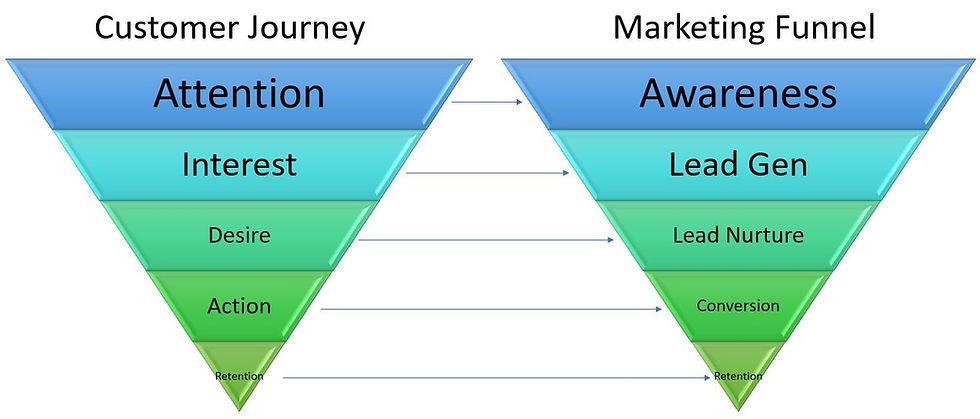Mapping Customer Journey to Marketing Funnel
- Boney Pandya
- Apr 21, 2019
- 4 min read
Lets start with some history:
Traditional Marketing ruled the world of marketing for a very long time. With the rise of television, radio, highway billboards etc. advertising saw great heights. When any new marketing opportunities like radio and television were evolving people were spending more and more to get a piece of the advertisement estate. The difference in ideology of that era and the era after the Internet explosion was of earth and sky.
Internet marketing provided with tools that were much more likely to give results than owning a costly billboard. For example, tactics such as search ads, social media ads, display ads, remarketing ads, and many other techniques can give options fulfilling every kind of business and industry at a much lower cost.
For someone to succeed in digital marketing understanding the customer journey properly is one of the key factors for success. With billboards, radio etc. the marketing is one size fits all. With digital marketing, you can customize your marketing message depending on what stage your customer is which in turn results in much better returns.
Lets take a look at the basic consumer journey.
Stages of a Consumer journey (AIDAR):
Attention: In this stage a consumer might not know about your offer and only have stumbled upon yours or someone else’s product.
Interest: To know more and to gather ideas a user goes searching for the product, related products, problem that the product solves, and build desire to own the product.
Desire: In this stage a user goes out to read reviews, product description, testimonials etc. before they could take a decision to purchase it.
Action: Once the user is certain that he or she is ready to spend their money on the product; they take action and purchase it.
Retention: A user who has already bought the product is now a loyal customer and is much more likely to buy a similar product or an extension of it rather than someone who is at the first stage or the subsequent pages of the consumer’s journey.
If you are thinking why we are going through the consumer journey than try to understand that your success in digital marketing very much depends on it. A buyer who is only at the first stage of the buyer’s journey can’t be pitched with an action, when an action is only taken by someone in the third stage.
If this makes sense to you, we are ready to go to the actual Digital Marketing framework.

With Digital Marketing, a complete path of a consumer journey can be automated to make sure that a consumer is taken step by step towards the end goal i.e.; to buy the product and continue buying it in future.
Funnel: The term funnel is used widely in Digital Marketing. Just as a funnel has a wide end and a narrow end, in any marketing channel the number of prospects in the first stage is more than the last stage of the funnel.
Our task before creating any such funnel is to keep the wider end as broad as possible to make the narrow end comparatively yield significant results.
The simple strategy of making a funnel is to bring traffic from as many places possible to our landing page and direct them to different pages and channels to complete different goals.
TOFU (Top of the funnel):
In this stage you want to identify prospects and convert them into website visitors. SEO, content, blog and social media post will help spread the brand awareness. You can also do some advertising at this stage. One example would be, if someone is looking for “spa services”. They are most likely to buy a spa service, and if you guessed it, this is the right moment to advertise your spa center if you have one.
MOFU (Middle of the funnel):
Now that the customer is aware about your brand and has visitors to your site, it will be ideal to show them value of products and services. Your goal at this stage is to capture the user information and send them customized messaging based on their interest. Content is the key at this stage of the funnel. Tactics you should use here to deliver the message to the customer are retargeting, social media, content marketing and email.
BOFU (Bottom of the funnel):
You have provided the customer with information about your products and services, now you would want them to convert into buyers. A great way to entice them is with offers, promotion, case studies, sale, early-bird etc. If they have been engaging with your content in the MOFU, you can help them make the decision with a consultation or by speaking to a rep. Once the customer has bought your product, its now time to move them to the retention campaign.
This is the complete Digital Marketing Framework, applying it is always tricky as the strategy can be different for different businesses, but the result of this framework is almost certain.
I would like to extent my wishes for your business endeavors, good luck and I hope this small article helps you in increasing your business revenue.

Comments